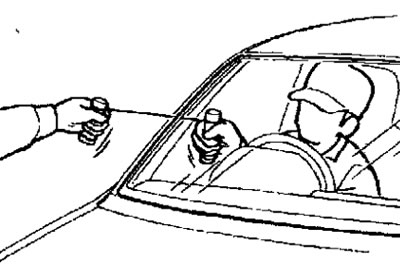
Pic. 17.9. Windshield: 1 - water-removing roof molding; 2 - windshield retainer; 3 - windshield; 4 - windshield spacer; 5 - spacer; 6 - top molding; 7 - overlay; 8— latch
Removing
- Remove the upper upholstery of the front pillars.
- On both sides of the car, remove the roof wicking moldings with a special tool (pic. 17.10). If the molding is deformed, replace it.

Pic. 17.10. Using the Special Tool to Remove the Roof Drainage Molding
- To protect painted body surfaces from scratches and damage, cover them with cloth tape around the installed windshield.
- Use a sharp thin drill to drill a hole in the adhesive layer and thread a steel string through this hole.
- With a steel string like a hacksaw, saw through a layer of glue around the entire perimeter of the glass (pic. 17.11). The string wire must not touch the edge of the windshield.

Pic. 17.11. Using a string to saw through the glue around the entire perimeter of the glass
- If the glass is to be re-installed, put alignment marks on the glass and on the body.
- Remove the windshield with the special tool (pic. 17.12).

Pic. 17.12. Removing the windshield
- Use a knife to cut off the remnants of the old glue along the entire perimeter of the body opening to a thickness of no more than 2 mm (pic. 17.13).

Pic. 17.13. Cutting off the remnants of the old glue around the entire perimeter of the body opening
- Sandpaper the edges of the flanging of the body opening and remove burrs.
- When reusing the windshield, remove the adhesive from the windshield and clean the glass with isopropyl alcohol.
- Clean the body in the same way. After cleaning the surface of the adhesive layer, wait three minutes for it to dry completely. Do not touch the cleaned surface.
Installation
- Install the spacer in the location shown in Figure 17.14.

Pic. 17.14. Location of spacer
- When replacing the windshield, temporarily install the windshield and use a special wax pencil to mark its position by drawing marks in 4 places on the glass and on the body.
- Use isopropyl alcohol to clean the inside and outside of the windshield and body frame.
- Soak a sponge in the primer and apply the primer evenly to the windshield and body frame in exactly the right places.
- After applying the primer, dry the glass for 3-30 minutes. The primer increases the adhesion of the adhesive, so be sure to apply the primer evenly around the perimeter of the windshield and onto the body frame. Keep in mind that a thick layer of primer will weaken the adhesive power of the adhesive. Never touch the primer surface with your hands. If this happens, the material may not properly bond to the glass, causing leaks and water leaks after the glass is installed.
- Fill the gun with glue. 30 minutes after applying the primer, apply an even layer of adhesive around the perimeter of the glass. To facilitate the extrusion of glue, cut the syringe nozzle at an angle, as shown in Figure 17.15.

Pic. 17.15. Applying a layer of adhesive to the windshield
- Install the fasteners on the holders.
- Align the alignment marks on the glass and the opening of the body and lightly press the glass evenly around the entire perimeter until it is completely glued.
- Use a spatula to remove excess extruded adhesive and wipe the surface with isopropyl alcohol. Before the adhesive hardens, install the water-removing molding. Try not to move the car until the adhesive has hardened.
- Wait at least 30 minutes and check the tightness of the adhesive joint. Use a jet of cold water, but be careful not to direct a strong jet of water at the new adhesive. Let the water run off the edges of the glass.
Warnings
- (1) Do not move the vehicle unless necessary.
- (2) When checking the tightness, do not pinch the tip of the hose to spray the water jet.
- If there are leaks, dry the area to be checked and then reapply the adhesive.
- Install all previously removed items.
